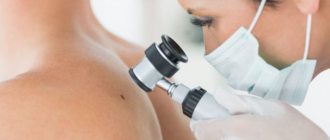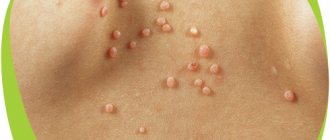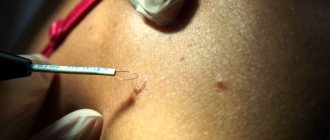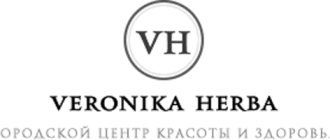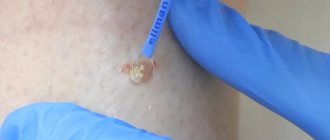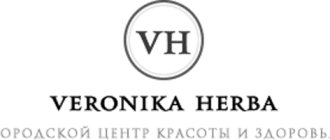A neoplasm is an excessive growth of tissue consisting of modified cells. Pathological cells multiply even after the factors that caused their growth are eliminated, so they are removed. Removing skin tumors requires a special approach, in particular, the procedure should be minimally traumatic and not leave behind unsightly scars.
Appointment with a dermatologist - 1000 rubles. Consultation on diagnostic results (optional) - 500 rubles.
MAKE AN APPOINTMENT, TEST OR ULTRASOUND
Removal of moles and warts using the Surgitron radio wave apparatus
Moles or pigmented nevi are the most common neoplasms of smooth human skin. They are usually benign in nature, so they are eliminated only if there are medical or cosmetic (aesthetic) indications. The Podology Clinic successfully practices the removal of skin tumors (moles and warts) using the Surgitron radio wave apparatus.
Types of tumors removed by radio wave method
Removal of neoplasms using the radio wave method includes the removal of moles, vascular mesh, keratosis, papilloma, fibroma. It is necessary to get rid of tumors, especially if there are certain indications. Each growth on the skin is fraught with a certain danger:
Warts
Warts are neoplasms that arise at the junction of the two upper layers of skin - the epidermis and dermis. The formation rises above the surface of the skin and has a dense stratum corneum. Children are frightened by the fact that warts appear because they touch frogs and toads, and they allegedly infect them with an unknown virus. Warts are actually a type of human papillomavirus.
Sometimes warts appear in adolescence (juvenile warts) during a period of rapid hormonal changes and weakened immunity. Neoplasms in children are eliminated on their own as soon as adolescence passes and immunity is restored. Plantar warts are dangerous. In appearance, they resemble calluses, but constant friction threatens injury and further degeneration into a more aggressive form.
Moles
Moles are benign neoplasms found in almost every person. Moles or naevus maternus are made up of melanin-producing cells. They are dangerous due to their degeneration into basal cell cancer cells and melanoma, a malignant skin tumor. Moles larger than 1 cm in size, with swelling and pigmentation of varying intensity should be removed.
There are various ways to get rid of nevi and moles on the skin, but one of the safest methods is to remove tumors using the radio wave method.
Keratoma
Keratoma is a benign proliferation of epidermal cells (keratinocytes). Due to the exposure of the skin to ultraviolet light, the keratinized cells stop exfoliating, and they accumulate and become keratinized. Keratomas often become injured and bleed. They can degenerate into cancer, so it is recommended to remove them.
Fibroma
Cutaneous fibroma looks like a dense sac localized under a fold of skin. If its height does not exceed 2 cm, it is better not to touch the fibroma.
Papillomas
Papillomas are skin formations that are the result of infection with the human papillomavirus. About 90% of the world's population is infected with HPV, but not all neoplasms have a risk factor. It all depends on the strain of the virus, and sometimes skin manifestations go away on their own. But they have an unaesthetic appearance, so they are often removed from open areas of the skin.
Condylomas
Condylomas are viral tumors on the mucous surfaces of the body. Transmitted only through sexual contact. Some strains are especially dangerous because in 99.9% of cases they cause cervical cancer in women.
Condylomas on the surface of the uterus provoke miscarriage, and in men they cause bladder cancer. Removal of such tumors is carried out using the radio wave method, because it is the most effective and safe.
How does Surgitron work?
Surgitron, used in the Podology Clinic, is an original portable medical device for radio wave surgery, manufactured by Ellman (USA). It is also called a radio knife, because it is a modern and highly effective alternative to the classic scalpel.
Surgitron uses highly targeted short high-frequency radio waves (3.8 - 4.0 MHz) supplied to tungsten electrodes. They lead to almost instantaneous low-temperature evaporation of intracellular and extracellular fluid and the cells themselves. This is accompanied by local dry coagulation, so that the cut surface is immediately covered with a dense crust and does not bleed. And the antiseptic (disinfecting) effect of radio waves prevents infection of the surgical wound.
The electrodes do not heat up during operation. All processes occur at a temperature of 38 - 40°C, without burns and obvious swelling of surrounding tissues. The incisions for radio wave removal of warts and other formations are very narrow and low-traumatic. Therefore, postoperative wounds heal quickly and painlessly, with the formation of a soft, inconspicuous scar.
Another advantage of the method is the obtaining of high-quality tissue samples for histological examination. This is especially important when removing moles and tumor-like formations with Surgitron.
What is the radio wave method, when is it used, advantages
The content of the article
The radio wave method of tumor removal involves the focused impact of high-frequency radio waves on the tumor in order to excise it. The radio wave acts like a surgeon's scalpel, but does not leave behind blood, because at high temperatures the blood instantly coagulates. A mole or any other formation is removed along with a small area of healthy tissue. The incision is very small and does not leave any scars.
Removal of tumors using the radio wave method is carried out in the following cases:
- the nevus increases in size, changes color, and hurts;
- neoplasms grow and occupy an increasingly larger area;
- moles change shape and bleed.
The main advantage of the radio wave method is the ability to remove tumors of any type, even those located in the deep layers of the skin. Other advantages of the method include the following:
- no need for stitches or bandages;
- the procedure is completely bloodless, it is suitable for people with blood diseases;
- the operation is performed under topical anesthesia, it does not require anesthesia;
- the procedure lasts 5-20 minutes;
- healing occurs in 3-10 days, depending on the area of the tumors being removed;
- minimal possibility of relapse (no more than 6%);
- used where cryodestruction (exposure to liquid nitrogen) and laser removal is impossible (for example, on the eyelid);
- tissues after removal can be sent for histological examination.
What can be removed by radiosurgery?
- Moles (nevi).
- Neoplasms resulting from human papillomavirus infection. These include: warts (common, plantar), condylomas, papillomas.
- Unaesthetic keloid and hypertrophic scars.
- Hemangiomas (point or star-shaped superficial vascular formations formed by intradermal small veins).
- Tumors and hyperplasia of skin appendages: sebaceous and sweat glands, hair follicles.
- Dermatofibromas are benign skin tumors formed by connective tissue.
- Granulomas are the name given to intradermal nodules that are inflammatory in nature and formed by overgrown connective tissue and an accumulation of immune cells capable of phagocytosis.
- A cutaneous horn is a cone-shaped, horny projection of skin formed by an excessive accumulation of keratinized cells and scales.
- Seborrheic or senile keratosis. This is a local accumulation of epidermal keratinizing cells, with the formation of pigmented protruding plaques-keratomas on the skin.
How is removal done using radio waves?
The operation is performed using a radio wave knife that emits high-frequency waves. Radio waves act on neoplasm cells that contain fluid. The water absorbs the waves and begins to boil, as a result of which the integrity of the cell is destroyed.
When a wart ruptures, particles containing papillomavirus are released from the cells, so the room must be sterile so that the people in it do not become infected with the virus. An exhaust hood should also be installed in the room for constant air circulation.
Before the procedure begins, the patient is injected with anesthesia or a special pain-relieving ointment is applied.
The duration of the operation varies from 15 to 30 minutes (the parameters of condylomas and their number are taken into account). After heating the knife, cutting off the growth and cauterizing the tissues located nearby begins. With the help of cauterization, the manipulation is bloodless.
Removal of moles with Surgitron
Removal of moles with Surgitron is an outpatient procedure. Its duration depends on the size of the nevus being removed and the type of local anesthesia used. With injection anesthesia, the operation lasts no more than 10 - 15 minutes and begins almost immediately after intradermal or subcutaneous administration of the drug, and in the case of application of a cream or patch, it can take about 1 hour.
The entire mole is cut out, including a small rim of unpigmented and healthy-looking skin. The crust that forms in its place must be treated with a solution of potassium permanganate (potassium permanganate), trying not to damage or wet it for several days. This will give it the opportunity to fully develop and prevent the formation of a rough scar. You can take a shower, but it is advisable to abstain from baths and saunas for a while. Over the next few months, it is recommended to apply sunscreen with an SPF of at least 50 to the surgical area.
What to do after the procedure
The radioknife acts on the tumor, evaporating the tissue. A crust forms at the site of exposure, which quickly heals without leaving a scar. After the procedure, the wound should be treated with a solution of vodka and iodine, and after the crust falls off, with Panthenol wound spray.
If you have at least once applied for removal of tumors, avoid being in direct sunlight. Moles, keratomas and other formations indicate that the skin has a low protective reaction to ultraviolet radiation; melatonin is produced unevenly, accumulating in damaged areas. Even when going outside normally, you should use creams with a high SPF content.
Be sure to strengthen your immune system, because HPV indicates a weakening of the body’s immune functions. After the procedure, you should visit a dermatologist every year.
Cost of tumor removal
The price of radio wave surgery depends on the type of anesthesia, volume and type of tissue removed. The final cost of the procedure also includes a consultation with a doctor and a histological examination of the removed tissue (if there are indications for this). You can view the current price of this procedure on the price list page.
The Surgitron radioknife is an effective modern surgical instrument in the hands of a qualified doctor. With its help, you can not only rid the patient of skin lesions, but also avoid the formation of rough, visible postoperative scars. The photo gallery of our Podology Clinic clearly proves this.
The use of modern radiosurgical techniques gives a high cosmetic result, allowing the patient to quickly and painlessly relieve the majority of unattractive and uncomfortable skin tumors.
The specialists of the Podology Clinic are highly qualified and have extensive clinical experience in the successful use of Surgitron. A competent and gentle approach, the use of effective modern painkillers, careful adherence to aseptic rules - all this ensures a highly aesthetic result.
You can clarify your questions and make an appointment with a dermatologist by calling the phone number listed on the website in the “contacts” section.
Indications and contraindications for the procedure
Radio wave therapy is prescribed by a doctor after diagnosing the patient and establishing a reliable diagnosis. The main indication for manipulation is a benign wart on the skin.
Doctors prefer surgical methods when the growth changes color, grows rapidly, or partially disappears. If other treatment methods do not help, the patient has to agree to surgical excision of the papule. Contraindications to radio wave treatment include:
- malignant tumors;
- allergic reactions;
- glaucoma;
- ARVI;
- diabetes;
- the occurrence of inflammatory processes in the body.
Radio wave therapy is also not recommended for patients with hypertension and epilepsy. It is prohibited to prescribe the procedure to people with installed pacemakers. If a person feels unwell before the procedure, they should inform the specialist about this in order to avoid complications and negative consequences.
Laser excision or radio knife
Removing a growth using a radio wave knife has a number of advantages compared to laser excision:
- Healthy cells are 23 times less susceptible to injury.
- Unlike laser removal, radiosurgery rarely leaves scars, and there are practically no negative consequences.
- More careful monitoring during surgery. Surgeons can monitor the depth of excision through visual observation and palpation. With laser therapy this is much more difficult.
- The recovery period lasts less.
Prices for radio wave removal of papillomas
| Removal of papillomas and milia on the eyelids and in the eye area For optimal preparation for the procedure, write to me | 950 rub. (1 PC) |
| Removal of 2 to 5 papillomas | 1950 RUR . |
| Removal of 6 to 10 papillomas | 2550 rub. |
| Removal of 20 papillomas | 5100 rub. |
| Removal of 30 papillomas | 7650 rub. |
Many people have papillomas on the skin of the face or body.
Some have less, some have more. Some people don’t pay attention to them at all, others dream of getting rid of them. If you are also looking for a way to solve this problem, read this text to the end. In this short article I will talk about a new effective way to remove papillomas
, which I use in my practice -
radio wave surgery
. However, a little clarification is needed first.
Areas of use
The scope of application of the method is quite diverse. Its advantages are:
- fairly affordable price;
- minimal probability of relapse (2-3%);
- minimal blood loss (excellent coagulating effect);
- fairly quick recovery after the procedure;
- minimal trauma to the skin surface and mucous membranes;
- minimal likelihood of scarring;
- there is no contact of the device with the skin (the possibility of infection is excluded);
- it is impossible to get burned;
- There is no necrosis of tissue edges.
- no hospitalization required;
- in most cases, anesthesia is not required;
- sterility of the procedure;
- no additional treatment of the treated area with medications is required;
- there are no negative consequences in the form of swelling and pain;
- allowed for use in women who have given birth;
When should warts be removed?
Removing warts on the face is not in doubt, since they are in plain sight and often cause psychological discomfort. For medical reasons, it is recommended to remove long-standing warts, as well as those located in places with regular mechanical or chemical irritation. It is better to remove the formation if it is located:
- in places where belts, straps, shoulder straps, collars fit;
- wearing rings and chains;
- friction of the straps of bags, backpacks, etc.;
- large folds of skin in obese people;
- under the breasts, if they are large;
- on the scalp;
- in places where hair is regularly removed by shaving or depilation.
The latter include the areas of the armpits, bikini, mustache and beard in men. Warts are removed not only for medical reasons, but also for cosmetic reasons, if their appearance causes discomfort in a person.
Types of warts
Warts are tumor-like pathological elements on the surface of the skin or (less commonly) mucous membranes.
There are several types of warts, which differ in appearance and location. Common warts are most often located on open, easily injured areas (knees, fingers, hands) and are dense, painless nodules covered with intact skin. Over time, cracks and growths appear on the surface of ordinary warts.
Plantar warts are localized on the soles of the feet in areas of increased pressure or friction from shoes. In its development, this type of wart goes through an evolution from a small shiny nodule to a rough plaque covered with keratinized scales. Plantar warts, as a rule, are not numerous (up to 3-5 elements), but they cause a lot of trouble for their owner due to severe pain.
Advantages of radiofrequency surgery and the Surgitron device
To use the wart removal service in Moscow, contact our center at any convenient time.
Minimal tissue damage:
- in terms of thermal damage to tissue, Surgitron is three times safer than laser devices and electrosurgical instruments;
- when exposed to the device, a blood clot does not form in the wound;
- during removal there is practically no risk of postoperative inflammation;
- necrosis of adjacent tissues is less than 20 µm deep.
The tissue is regenerated in a short time:
- already on the third day after removal, pronounced epithelization can be noted;
- after healing, a rough scar does not form;
- pain in the wound area is insignificant.
Radio waves have a sterilizing effect on tissue, which minimizes the development of complications after surgery.
Due to the short healing time of the wound at the site of the wart without the formation of a rough scar, an excellent cosmetic result is ensured.
Hardware destruction methods
Some warts may involute spontaneously (that is, disappear without outside intervention), but when or if this will happen is impossible to predict.
Dermatologists recommend removing warts, even if they do not cause discomfort. Moreover, now it is extremely rare to resort to a scalpel when removing small benign tumors. Hardware methods are less invasive, simple, safe and characterized by a short recovery period after manipulation.
Procedure
Warts must be removed by a doctor using special equipment. The procedure involves several successive steps:
- Anesthesia. An anesthetic cream or injection is usually used. When using the cream, it is important to wait for its action to begin - most often this takes no more than 10-15 minutes.
- Removal of formation. Exposure to radio waves allows you to completely separate the pathological area.
- Apply a bandage to the treated skin area.
Before the procedure, the doctor will tell you about possible restrictions and give recommendations for skin care.
Radio wave cutting of warts in children
Radio wave therapy does not last long and does not cause discomfort or pain, so it is prescribed even to children. To refer a child for the procedure, he must undergo an initial examination and diagnosis by a dermatologist.
The patient undergoes a general analysis of urine and blood, as well as an allergy test for drugs that are part of the local anesthesia.
During the procedure, the dose of radio radiation is minimal, which is why there is no potential danger to the child’s body. Nowadays, most private clinics perform radio wave cutting of papules for young children and guarantee a positive result.
